The
Home Page Selection
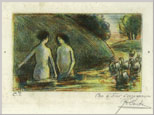 |
<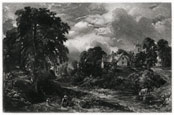 |
If
you require further information on any
print featured here, please contact
us.
When
a print has been sold it will be marked
as Sold.
A
growing archive of selections
from previous Home pages is featured in
the
Home
Page Selection Archive |
|
See
also :
Click
on a thumbnail (left)
to link directly with the entry for that
print, or scroll down to view all the selected
prints from the current Home
Page.
Images
are not to relative scale (see stated dimensions) and also at only modest resolution.
If you wish to view extracts of an image at higher resolution, please Contact us.
|
|
|
|
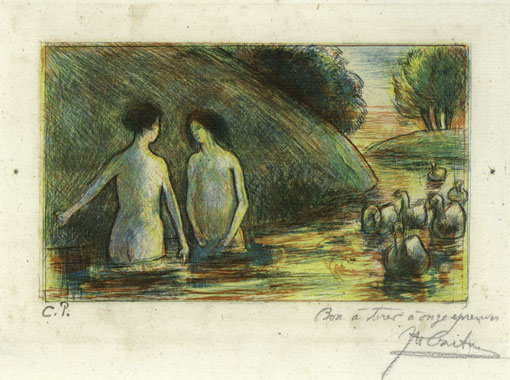
| |
CAMILLE PISSARRO
St Thomas, Danish Antilles 1830 – 1903 Paris
Pissarro arrived in Paris in 1855, the same year as Whistler,
and within a few years had made friends with the group of
artists who would come to be called The Impressionists.
He would be the only one of the group to exhibit at every one
of the eight ‘Impressionist exhibitions’.
He had made a few etchings prior to 1879, but it was Degas,
in that year, who revived his interest in printmaking, which
thereafter became an important part of Pissarro’s oeuvre.
His printmaking was mainly in black and white.
It was seeing Mary Cassatt’s colour etchings in 1891 that inspired
Pissarro to make his own five colour etchings. All are rare.
For their 1891 exhibition at the Galerie Durand-Ruel,
the Société des Peintres-Graveurs had decided to allow
only French-born artists to exhibit; which excluded both
Pissarro and the American Mary Cassatt.
She suggested to Pissarro that they themselves also exhibit
independently at the Galerie Durand-Ruel.
She showed her suite of ten colour etchings at this exhibition.
Pissarro probably first tried adding ‘colour plates’ to one or
two of his existing ‘monochrome plates’ for a colour edition
in about 1894, when he had acquired his own intaglio press,
while his other three colour etchings, all c1894-95, were
designed from the outset to only be printed in colour.
The main composition was etched on a ‘key’ plate and printed
in black ink. Localized colour was added sequentially from up
to three further plates printed respectively in red, yellow and blue inks.
In 1930 the Pissarro family arranged what was essentially the first
formal edition of Pissarro’s five colour etchings, printed for them
by Alfred Porcaboeuf and supervised by Jean Cailac.
A total of from twelve to seventeen impressions were printed of each
subject; eleven of these formed the numbered edition, one the
bon à tirer proof, authorised and signed by Jean Cailac, retained for
his personal collection, preceded by up to five trial proofs.
After the edition was printed the plates were cancelled and presented
to the Bibliotèque Nationale.
The bon à tirer proofs of all five etchings are offered in the catalogue.
Baigneuses gardeuses d’Oies
D.119 ix/ix
119 x 179 mm
Original colour etching, c1895.
The 1930 Bon à tirer à onze épreuves proof, annotated and signed
in pencil by Cailac twice (the repetition faint, at the lower sheet edge).
Stamped with Pissarro’s initials (Lugt 613e).
Printed from multiple plates in black, red, yellow and blue on old laid
paper with part of a bunch of grapes watermark.
Slight cockling in the
plate borders.
£POA
Ex collection Jean Cailac.
Pissarro himself printed 20 trial colour proofs through the different states,
and about a dozen numbered artist’s proofs printed in four colours
in the final state.
The 1930’s printing was of 13 impressions, including a single trial proof.
Return to top ^ |
|
|
|
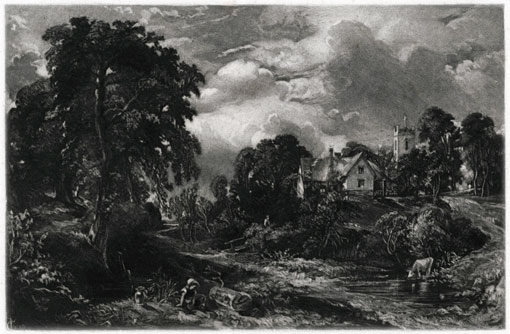 |
|
After JOHN CONSTABLE R.A.
East Bergholt 1776 – 1837 Hampstead
Constable began his project for a series of mezzotints
to show his practice of English Landscape Scenery, in 1829.
He selected subjects which he thought best showed the
natural drama of light in different weather conditions at
different seasons of the year, which he called the chiaroscuro of nature.
He worked in close collaboration with his engraver,
David Lucas (1802-1881), through a series of progress proofs.
The Glebe Farm, Green Lane
Shirley 19, progress proof g/g; Hill 20
176 x 252 mm
Mezzotint, engraved by David Lucas, 1832.
The plate signed in the
image with Constable’s initials.
A final progress proof.
On laid paper, with wide margins and deckle edges on two sides.
Sold
Constable began working on the painting of Glebe Farm, at Langham,
with a view of the church, in 1826, as a sort of memorial to his friend
and patron John Fisher, Bishop of Salisbury, who when Constable
first met him, about 1798, according to Hill, was rector of Langham.
Constable made four versions of the subject 1826-1830.
He wrote to his biographer C R Leslie, who owned an early version
of the painting This is one of the pictures on which I rest my little
pretensions to futurity.
Glebe Farm is the only plate of English Landscape Scenery to be signed.
Return to top ^ |
|
|
|
 |
|
GIOVANNI BATTISTA PIRANESI
Mozzano di Mestre 1720 – 1778 Rome
The son of an architect, Piranesi trained in Venice as a
theatre set designer and as an architect, though he would
only design one building, a renovation and redesign of the
church of Santa Maria del Priorato in Rome.
From his arrival in Rome in 1740 he concentrated almost
exclusively on etching, which he probably learnt from Giorgio Vasi,
the leading engraver of vedute in Rome in 1740
(who is said to have commented “You are too much a painter,
my friend, to be an engraver”).
Piranesi was captivated both by the contemporary magnificence
of Rome and its classical past, finding a powerful poetry in the
existing ruins and newly rediscovered sites.
Piranesi began his great series of the Vedute di Roma probably shortly before 1748, and added to them during the
remaining three decades of his life; the plates becoming
increasingly romantic and emotive in treatment, though
from the outset the architecture tended to dwarf the figures.
The earlier plates were initially issued by Bourchard & Gravier.
After his move, in 1761, to presumably much larger premises
in the Palazzo Tomati, Piranesi issued his own plates.
Veduta del Tempio di Cibele
a Piazza della Bocca della Verità
Hind 47 i-ii/v
402 x 612 mm
Original etching, 1758.
An early undescribed state, with the address
of Bourchard e Gravier.
On thick laid paper watermarked with a
Lily in a double Circle, with a ‘tail’ (Hind 2), typical of impressions
issued by Bourchard & Gravier.
With the usual unobtrusive central vertical fold.
Sold
As with several of Piranesi’s etched titles, this one,
in its assumed dedication of the Roman temple to Cybele,
is erroneous, though it is accurate in its location.
Being circular, the temple today is popularly known as the Temple of Vesta.
It may have been dedicated originally to Hercules Olivarius,
patron of the Portus Tiberinus oil merchants.
Hind calls it The Temple of Portunus? (The round temple near
Santa Maria in Cosmedin).
Return
to top ^ |
|
|
|
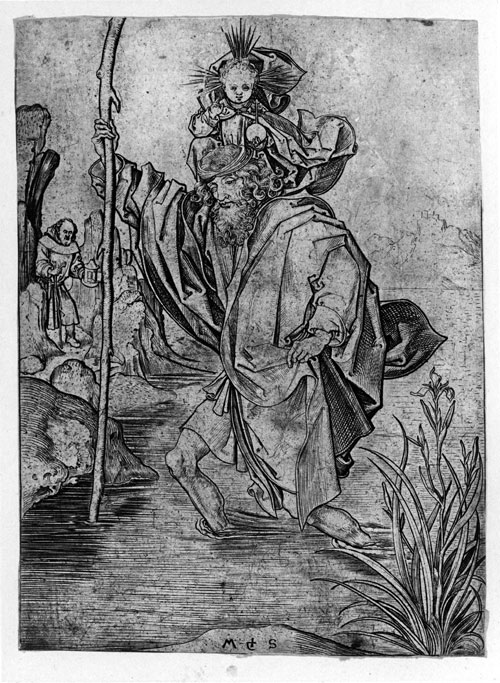 |
|
MARTIN SCHONGAUER
Colmar c1450 – 1491 Colmar
A son of a goldsmith of patrician descent, Schongauer
was educated at Leipzig University.
He had established a workshop as a painter and original
pictorial engraver, in Colmar, by 1471.
He made over a hundred engravings and can be considered
the first painter-engraver in Northern Europe.
He also was the first artist consistently to sign his plates.
Dürer greatly admired his work (Schongauer in his lifetime
was known as Hübsch Martin – Beautiful Martin, because of his work)
and collected Schongauer’s prints and drawings.
During his Wanderjahre, 1490-94, Dürer reached Colmar in 1492
hoping to meet Schongauer, but Schongauer had died the previous year.
St Christopher
Bartsch 48, Hollstein 56 only state
158 x 115 mm
Original engraving, the plate signed with the monogram.
A good impression, trimmed to or fractionally into the platemark.
Edge-mounted and partially laid down to the right of the saint’s
shoulder effecting a repair to a tear and related paper loss.
Occasional slight foxing.
£5000
Return
to top ^ |
|
|
|
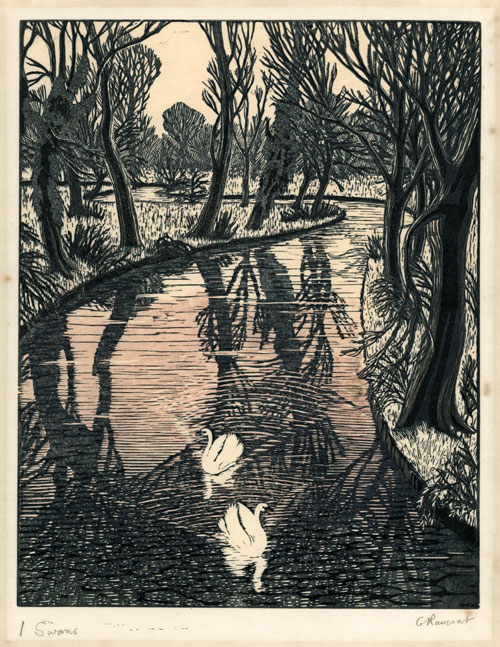 |
|
GWEN RAVERAT R.E., S.W.E.
Cambridge 1885 – 1957 Cambridge
The granddaughter of Charles Darwin and
cousin of Vaughan Williams, Gwen Raverat
attended the Slade in 1908, going on to the Sorbonne
where she met her husband.
She made her first wood engraving in 1909.
She was a founder member, the only woman,
of the Society of Wood Engravings in 1920.
Though she did occasionally hand-colour the occasional
wood engraving early on, Raverat’s first wood engravings
designed to be printed in colours date from 1939.
It was only after WWII, in 1946, that she concentrated
on colour engraving.
Swans
Raverat
554
235 x 185 mm
Original colour wood engraving, 1948.
Signed in pencil and entitled.
Edition of 26.
Printed from three blocks in black, green and pink, on japan.
A little time-stained and foxed in the margins.
Sold
Return
to top ^ |
|
|
|
|
|
|
|